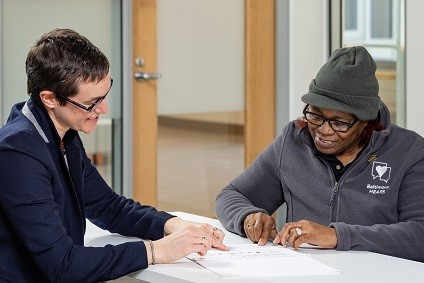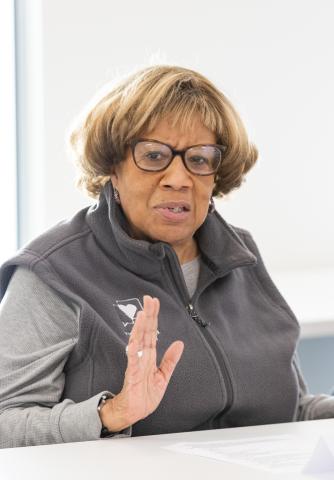All older adults deserve access to the tools they need for healthy aging. But there are gaps in who gets hearing care.
To bridge this gap in access, Cochlear Center researchers developed HEARS - Hearing health Equity through Accessible Research and Solutions.

Photo credit: Daniel Martinez, Johns Hopkins School of Nursing
Hearing care in the United States typically involves multiple visits to multiple providers and the out-of-pocket purchase of hearing aids. This process demands mobility, transportation, and financial resources along with a high-degree of health literacy and executive function to navigate the complex systems involved. Furthermore, the vast majority of hearing aid manuals and training materials are not suitable for older adults. Current approaches to hearing care fail to address these barriers and do not serve the majority of older adults.
HEARS is an accessible, affordable hearing care program that is theory-driven and evidence-based. The program is delivered by trained individuals, from community health workers with appropriate supervision to hearing experts. In close collaboration with the MICA Center for Social Design and a transdisciplinary team of experts from audiology, otology, gerontology and geriatrics, all training materials integrate best-practice design for older adults and empower users how to incorporate over-the-counter hearing technology into their daily lives.
The HEARS Approach
OTC Hearing Technology
High-quality, low-cost, over-the counter listening devices are currently available and blur the line between hearing aid and amplifiers. Through research by the Cochlear Center team, HEARS incorporates the current leaders in over-the-counter hearing technology in terms of sound quality and usability. As the over-the-counter hearing technology market grows, the HEARS materials can be adapted to the latest developments and features.
Tailored, User-Driven Training
HEARS teachers meet with clients in their community to deliver the program. The program can be completed in 1-2 sessions (a total of 1-2 hours) and is driven by the client’s communication goal. During the program, the client selects a device of his or her choice which is then fit for the client, and the teacher reviews an interactive step-by-step orientation to the device tailored to the individual’s communication goal and technology needs.
Essential Education & Counseling
The HEARS program includes an easy-to-follow introduction to age-related hearing loss and expectations around getting the most out of a listening device. The program incorporates communication strategies that the HEARS teacher and client practice together to equip clients with the tools they need to communicate and connect.
The HEARS program works.
The team found that participants’ hearing and communication improved significantly – all with a 2-hour program delivered entirely by community health workers using over-the-counter, low-cost hearing technology. Results of the randomized clinical trial were published in the Journal of American Medical Association. Access the JAMA publication.
The program is not intended to replace audiologists and otolaryngologists who have specialized training in hearing loss. The goal instead, Nieman says, is to “recruit and train community health workers who share some of the same lived experiences as those who go without hearing care, which represents the vast majority of older adults with hearing loss. From this position, CHWs can gain trust and connect with their clients in ways that hearing care professionals, like myself, often cannot.”
The HEARS trial validates a model of hearing care that empowers community health workers to reach older adults with untreated hearing loss. Further trials of the HEARS program are planned at three sites across Maryland, and Nieman is seeking collaborators and funding to grow the program globally.
The cross-disciplinary research team includes Frank Lin, Joshua Betz, Jonathan Suen, Jami Trumbo, Nicole Marrone, Hae-Ra Han and Sarah Szanton. This study was funded by the National Institute on Deafness and Other Communication Disorders.


